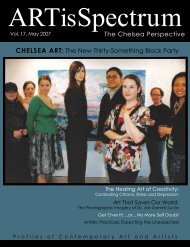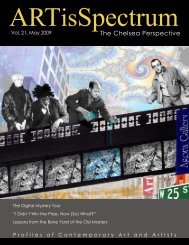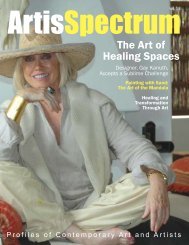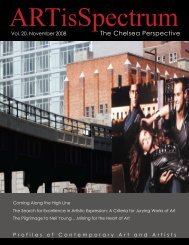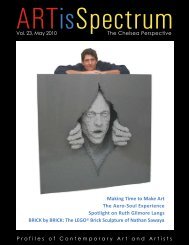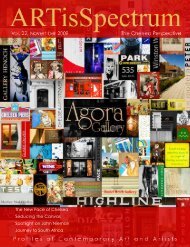Download PDF - ARTisSpectrum
Download PDF - ARTisSpectrum
Download PDF - ARTisSpectrum
Create successful ePaper yourself
Turn your PDF publications into a flip-book with our unique Google optimized e-Paper software.
Democratizing Art: Keeping Chelsea’s Open Doors Open<br />
by Benjamin Sutton<br />
Counting nearly four hundred galleries, Chelsea is by far<br />
the richest art district in the world. Rising to prominence<br />
within the competitive New York arts scene in the mid- to latenineties,<br />
the name “Chelsea” now holds currency across international<br />
art markets. As art dealer Perry Rubenstein told the<br />
New York Times in May 2007: “If you go to Berlin and tell<br />
an artist that you are only going to show them on 57th Street<br />
and not in Chelsea, they won’t show with you.” For the global<br />
gallery community, Chelsea is the center of the world. With<br />
boundless development in the area for over ten years now,<br />
one wonders how it will continue to change in coming years.<br />
Certainly a multitude of highly-anticipated developments<br />
promises continued vitality. Likewise, important additions like<br />
the High Line elevated park and the planned Whitney Museum<br />
expansion will provide long-standing institutions ensuring<br />
continued cultural relevance. The primary anxiety over<br />
the area’s future springs from fear of over-development and<br />
attendant rising rents. A survey of these factors illuminates<br />
Chelsea’s present situation and foreshadows the directions<br />
of future growth. Meanwhile, a look back to Chelsea’s predecessor,<br />
Soho, helps us understand the decline of that area’s art<br />
scene, and how that experience informs present-day Chelsea.<br />
a result, some expect less financially-secure galleries and not-forprofit<br />
organizations will be squeezed out by unaffordable rent.<br />
However, the most expensive spaces in Chelsea are still leased<br />
for less than half the rate of Soho spaces in the mid-nineties.<br />
Additionally, no other area in Manhattan can provide<br />
the same quality of space for what remains a relatively low<br />
price. For galleries whose success depends on the visibility<br />
and convenience of being in Chelsea, cheaper space in Brooklyn<br />
or Queens implies much less traffic and, ultimately, fewer<br />
sales. After all, part of what makes Chelsea so successful is<br />
its strength in numbers. The thriving gallery life provides sufficient<br />
attraction to bring people from all over New York and<br />
the world to what, otherwise, would be an out of the way area.<br />
Indeed, many speculate that Chelsea’s isolation from any<br />
major transportation hubs has helped pace its development.<br />
Whereas Soho’s central and accessible location<br />
quickly drew crowds of shoppers, diners and investors,<br />
West Chelsea has, until very recently, remained almost exclusively<br />
home to galleries and art-related organizations.<br />
A Pair of Public Projects<br />
Not to Go the Way of Soho<br />
Skeptics have long predicted that Chelsea’s gallery district will<br />
go the way of Soho in the late nineties. There, after a thriving<br />
set of galleries established themselves, encroaching restaurant,<br />
retail and housing developments monopolized space and drove<br />
rents higher than most galleries could afford. With some two<br />
hundred art spaces at its peak, Soho’s concentration and variety<br />
of contemporary art was a completely new phenomenon.<br />
To be sure, the idea of a concentrated area known for its rich<br />
slate of galleries was not new. 57th Street has long had a wellestablished<br />
set of art galleries catering primarily to wealthy inhabitants<br />
of the surrounding area. After all, the census tract most<br />
of the 57th Street galleries lie within has the highest median<br />
income in all of New York. Nonetheless, many galleries made<br />
the move to Soho to find a new audience, hoping for higher visibility<br />
in a booming area. To some extent, Soho was a victim<br />
of its own success. Accessible via multiple subway lines, set in<br />
a fairly central location, a mix of expensive new developments<br />
and coveted historical buildings quickly caused rent to skyrocket,<br />
favoring high-end restaurants and retail over art galleries. In this<br />
financial context, the move to an inexpensive wasteland of untapped<br />
warehouse space was risky but loaded with possibilities.<br />
To claims that West Chelsea will repeat Soho’s cycle of self-annihilating<br />
success, some responses present a direct challenge,<br />
and others betray striking parallels. Though space was boundless<br />
when galleries first migrated West in the mid-nineties, it is now<br />
hotly contested and accordingly priced. A Times article in March<br />
2007 reported that warehouse spaces in Chelsea that went for $8<br />
per square foot in 1994 are now leasing at ten times that rate. As<br />
14 ArtisSpectrum<br />
In the last few years many development projects, some public but<br />
most private, have begun shaping a new Chelsea. The most prominent<br />
and highly-publicized is certainly the High Line – the elevated<br />
railway that several world-renowned architecture firms with<br />
offices in the area are turning into a public park. The park, whose<br />
first stretch opens this fall, will be an attraction unto itself, bringing<br />
new visitors to the area. Though it’s hard to speculate what its<br />
impact will be as subsequent stretches are completed, the prospect<br />
of greenery among the concrete, steel and glass is exciting.<br />
Another important public development is the major cultural<br />
institution that will anchor the High Line at its Southern-most<br />
end, near the intersection of Little West 12th and Washington<br />
Streets in the Meatpacking District. When the project was<br />
first conceived, two potential institutions were in nearby temporary<br />
spaces and expected to leap at the opportunity. Surprisingly,<br />
both the Dia Art Foundation and the New Museum<br />
for Contemporary Art chose other locations, and this early<br />
setback tempered the optimism surrounding the High Line.<br />
Since then, though, the Whitney Museum of American Art has<br />
announced its scheme to build a much-needed new structure on<br />
the site. The plans are not final, but there is reason to be optimistic.<br />
This would provide a second major art institution in<br />
the Chelsea art district, with the Whitney in the area’s Southern<br />
section complementing the more centrally-located Chelsea<br />
Art Museum on West 22nd Street. The new Whitney building,<br />
meanwhile, would be even larger than its current Upper East Side<br />
building, which it would continue to use also. The Whitney has<br />
retained Renzo Piano – whose recently-opened new New York<br />
Times Building has been deemed an architectural triumph – to<br />
design this new museum. The architectural standard set by the





